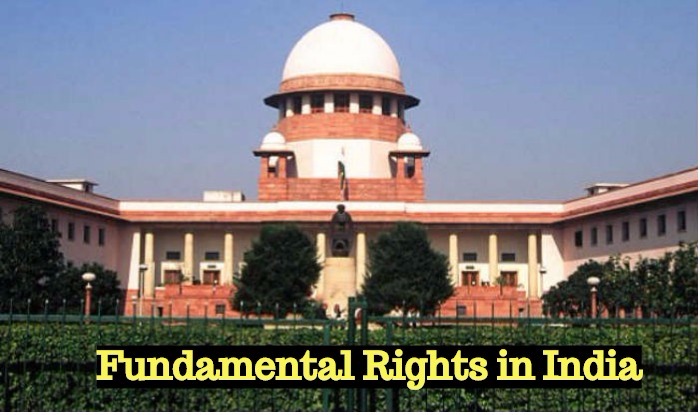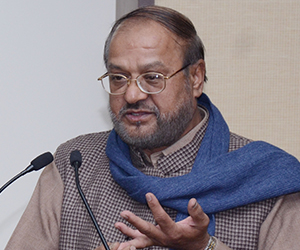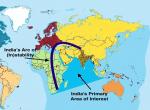The Constitution of India came in force on 26 January 1950. In the Constitution, Fundamental Rights (Part-III of the Constitution) of the citizens and the Independent Judiciary have been considered as most sacred and precious. The Fundamental Rights of a citizen clearly envisages the rule of law, right to personal liberty, freedom from arbitrary arrest and detention, right to dissent which implies freedom of speech and expression of individual as well as press, and the right of aggrieved person to go to the court of law. In this article we shall have a look at the some of the amendments that had crucial bearing on the overall the functioning these constitutional provisions.
The Beginning
Within four months of the Constitution coming in force, on 12 May, 1950, the Congress Government of Pandit Nehru placed a draft of the first Constitutional Amendment to the Parliament and this was concerning Article 19 (Fundamental Right of the Part-III of the Constitution). Before we proceed further let us see what this Article deals with:
Article 19. Protection of certain rights regarding the freedom of speech etc. :–
- All Citizen shall have the right:—
(a) to freedom of speech and expression;
(b) to assemble peaceably and without arms;
(c) to form associations or unions;
(d) to move freely throughout the territory of India;
(e) to reside and settle in any part of the territory of India;
(f) to acquire, hold and dispose of property (deleted by 44th Amendment w.e.f. 20.6.1979); and,
(g) to practice and profession, or to carry on any occupation, trade or business.
It is this part of the Constitution which provides dignity and power to the people to fight injustice and restricts the government from doing away with self-respect and the liberty of the people. It has been the experience from around the world that governments have made efforts to take away precisely such constitutional provisions that provide dignity, self-respect and freedom of various kinds to the people and to make the people and the country into a party’s slaves and the country itself into a despotic state.
Because the functioning style of the central and provincial governments came in for very severe criticism by the opposition parties as well as by the press, the Government wanted to amend the Article 19 to curb freedom of speech in order to deal with the criticism. Prime Minister Nehru was very disturbed because of adverse decisions by the High and Supreme Courts in the cases of zamindari abolition, nationalisation of road-transport etc. Many party leaders, especially Sardar Patel (to whom he already had written letters and was unhappy that Patel did nothing to suppress the criticism), intervened, and advised Pandit Nehru not to resort to such an amendment as it was too early for any such action. Further, the Parliament which had passed the Constitution was only a provisional one and perhaps it did not have the power to amend it. It was said that constitution of the new parliament must be awaited for to take up the amendment(s).
But after a few months, in February 1951, the Government constituted a Cabinet Committee to look into the matter of criticism in the press and by the opposition leaders and as to how to deal with it. The Committee was attended, besides Nehru, by such stalwarts as C. Rajagopalachari, Maulana Azad, Jagjivan Ram, K.M. Munshi, B.R. Ambedakar and others.1Pandit Nehru also invited suggestions from his colleagues. G.B. Pant, then Chief Minister of Uttar Pradesh, wrote that freedom of speech was being “wantonly abused….venomous and filthy attacks were being made… against the centre and state governments…. maliciously and in an extremely vulgar and indecent manner.” 2
To the Government’s efforts to usher in various economic reforms, including the land reforms, setback came from various High and Supreme Court decisions delivered against many laws framed to meet that end. Unfortunately, some of such laws transcended the line of peoples Fundamental Rights. Many Congress leaders and Chief Ministers of some of the States requested Nehru that “reasonable restrictions” 3 must be imposed on the Article 19. In light of the Congress leaders’ suggestions, Jawaharlal Nehru asked the Law Minister Dr. Bhimrao Ramji Ambedkar to prepare a draft for amendment to the Constitution. Ambedkar warned that doing so would be against the letter and spirit of the Fundamental Rights enshrined in the Constitution. But Nehru insisted and asked Ambedkar the same day that he should prepare the amendment draft bill to be placed before the Parliament in the same session.
Once the draft bill was ready, it was sent to Dr. Rajendra Prasad, President of India, for his perusal. President raised serious objections to the draft bill. Citing his understanding of various High and Supreme Court decisions, the President said that no occasion to amend the Fundamental Rights had arisen, and that amendments should come only if it was found impossible to bring the impugned provisions of law in conformity with the Constitution. Further, the President said that such an amendment should not be hurriedly pushed in; enough time should be given for discussions and wider consultations on such a vital bill. 4
The Pandit Nehru ignored the advise of Dr. Rajendra Prasad - Sardar Patel was no more on the scene to restrain him. On 12 May 1951, the Amendment Bill was laid on the table in the Parliament. Leaders like H.V. Kamath, Hriday Nath Kunjru, Syama Prasad Mukherjee and many others said in one voice that this was not an amendment but complete abrogation Article 19. Due to very strong opposition to the bill, Nehru agreed to refer it to a Parliamentary Committee. After extensive amendments in the bill was passed as The Press (Objectionable) Act, rather than as an amendment to Article 19.
After Independence, as mentioned earlier, the Government of India and the State governments had started implementation of agrarian reforms which entailed taking away large chunks of lands from landlords without giving much compensation and giving the ownership rights to the tenants. This action of the Government was challenged in various High Courts as the reforms directly violated the Fundamental Rights granted under Articles 14, 19 and 31, especially the right to property (see 19(f) above). Bihar Land Reform Act, 1950, was the first enactment on agrarian reforms that was challenged in Patna High Court. 5 The petition was allowed and the law regarding land acquisition declared void. To overcome this problem and to shield such laws with regards to the provisions of the Fundamental Rights from future interference of the Courts, Article 31A and 31B and Schedule Nine were inserted into the Constitution. Several other Articles were amended. This was the First Amendment which became effective on 16th June, 1951.
Subsequently, questions were raised whether under Article 368 the Parliament had the power to amend any article related to Fundamental Rights. Validity of the newly inserted Article 31B was challenged as it abridged the rights conferred under Article 13. 6 On various technical grounds, the petitions was disallowed and the amendments were held valid. In a way, the Supreme Court validated Government’s actions.
It would be important to quote here the Article 13 of the Constitution as we shall find it appearing in the article again and again. Article 13 states:
13. Laws inconsistent with or in derogation of the Fundamental Rights:-
- All laws in force in the territory of India immediately before the commencement of this Constitution, in so far as they are inconsistent with the provisions of this Part, shall, to the extent of such inconsistency, be void;
- The State shall not make any law which takes away or abridges the rights conferred by this Part and any law made in contravention of this clause shall, to the extent of the contravention, be void;
- In this article, unless the context otherwise requires:–
(a) law includes any Ordinance, order, bye law, rule, regulation, notification, custom or usages having in the territory of India the force of law;
(b) laws in force includes laws passed or made by Legislature or other competent authority in the territory of India before the commencement of this Constitution and not previously repealed, notwithstanding that any such law or any part thereof may not be then in operation either at all or in particular areas.
(4) Nothing in this article shall apply to any amendment of this Constitution made under Article 368 Right of Equality (Inserted in the Constitution through the 24th Amendment Act, 1971).
Article 13 is the key provision as it is due to this article that the Fundamental Rights cannot be infringed upon by the government either by enacting a law or through administrative action, and if the case is otherwise, it makes these justiciable.
The issue was soon back in the Supreme Court when the 17th Amendment was passed and came in force on 20 June 1964, i.e. just about three week after the death of Jawaharlal Nehru. In this, the Article 31 was amended to curtail Fundamental Rights, and 46 bills were placed in the 9th Schedule so as to exclude scrutiny by the courts. The bill mainly dealt with land reforms. The 17th Amendment was challenged through a writ petition popularly known as Golak Nath v State of Punjab. 7 The case was heard by 11 judges bench presided by the Chief Justice K. Subba Rao. The Government counsel argued that under Article 368, Parliament had unlimited power to amend any part of the Constitution including even Part-III, and take away whatever has been guaranteed under this Part.
The case was decided by a majority of 6:5. The majority decision overturned the earlier judgments given in the cases of Kameswar Prasad, Sankari Prasad, Sajjan Singh etc. The judgment invalidated also the amendment in Article 31. It was held by the majority judgment that according to Article 13(2), “The State shall not make any law which takes away or abridges the rights conferred by this Part and any law made in contravention of this clause shall, to the extent of the contravention, be void.” Therefore, all constitutional amendments thus far which were in contravention or which had made exceptions to Fundamental Rights were declared to be void. The majority judgment laid down emphatically that under no circumstances any provision enshrined in the Fundamental Rights could be amended, and thus imposed a blanket ban on amending any provisions in Part-III of the Constitution. The judgment further said that amending powers of the Parliament was not unlimited; in fact, it was very limited.
The Middle Phase
In between the Golak Nath and Keshavananda Bharati Cases there are two important cases that need to be briefly discussed before we come to the Keshavananda Bharati Case, the penultimate landmark in the history of Indian jurisprudence.
It is well known that in order to pursue her socialist policies, Mrs. Gandhi took several populist measures in the realm of economy. In having greater resources at the disposal of the Government, she nationalised 14 private banks which had almost 85 percent of the total bank deposits. For this, the Government promulgated an Ordinance effective from the midnight of 19 July, 1969, though an Act was passed within three days by the Parliament to replace the Ordinance.
A writ petition was filed 21 July, 1969, by Mr. Rustom Cavasjee Cooper challenging the Ordinance/Act. The case is also popularly known as the Bank Nationalisation case. 8 In view of the gravity of the issue, the petition was heard by a constitution bench of 11 judges. The importance of the case can be understood by the fact that form the petitioners side the advocates were Nani A. Palakhiwala, M.C. Chagla a former Chief Justice of Bombay High Court and former Education and then Foreign Minister of Mrs. Gandhi’s Cabinet, A.J. Raja, N.N. Palkhiwala, and R.N. Bannerjee. From the defence side, advocates were such stalwarts as Attorney General Niren De, Solicitor General Jagdish Swaroop, former Attorney General M.C. Setalvad (popularly known as Mr. Law), former Attorney General C.K. Daphtary and R.H. Dhebar. The petitioner challenged the validity of Ordinance and argued of violation of Fundamental and Constitutional Rights. Further, it was argued that the as per the Article 31(2), the Constitution guarantees the right to compensation, that is, the equivalent money to be paid for the property compulsorily acquired.
The case was decided by a majority of 10:1. Of the 11 judges’ bench only Justice A.N. Ray dissented. In its majority judgment, the Court held the Ordinance-Act to be valid, i.e. within the legislative power of the Government. It, however, declared the Ordinance void on merit. It did not denationalise the banks but increased the compensation of such banks.
Another case that needs to be discussed briefly here is the Abolition of Privy Purses to the former rulers of erstwhile independent states. When India became a free nation, it consisted of British ruled territories and 563 independent States ruled by Maharajas, Rajas, Nawabs and Nizam. It was the persuasive and diplomatic skills of Sardar Patel and his right hand man V.P. Menon that all the rulers agreed to merge their independent states into India. Patel had promised not only to maintain their honourifics but also a modest financial pension to keep them afloat. To guarantee payment of Privy Purses and also to preserve personal rights, privileges and honours of the rulers, Patel got the entire arrangement incorporated into the Constitution as Articles 291 and 362. The Privy Purses amounts varied from Rs. 43 lakh a year to the Nizam of Hyderabad to just Rs. 192 a year to the ruler of Kaodiya. Of the 563 rulers, 398 were getting less than 50,000 a year. The total burden to the exchequer was Rs. 6 crore in 1947 which was progressively reduced and in 1970 it was barely Rs. 4 crore.
The All India Congress Committee passed a resolution on 25 June, 1967, to abolish the Privy Purses. The 24th Amendment Bill was introduced in Lok Sabha in 1970 and passed, but got defeated in the Rajya Sabha. Having failed in Parliament Mrs. Gandhi had a Presidential Ordinance to derecognise all the erstwhile rulers. Madhav Rao Sindhia, who later joined Congress, filed a writ petition in Supreme Court.9 The case was heard by 11 judges bench presided by Chief Justice M. Hidayatulla. The Judgment came on 15 December, 1971. Palkhiwala won the case for the petitioners by an overwhelming majority. Majority of 9:2 held that the Government’s action of abolishing Privy Purse was wrong. Only two judges – A.N. Ray and G.K. Mitter gave dissenting judgements.
Piqued by the judgment of Supreme Court, the Congress Government retaliated by affecting the 24th Amendment to the Constitution by altering Article 13 of the Constitution. The details of Article 13 have been enumerated above. Through the 24th Amendment a clause (clause 4) was added to the Article 13 of the Part III of the Constitution. The added clause read: “Nothing in this article shall apply to any amendment of this Constitution made under article 368”. With the addition of this one small sentence into the Constitution, the Government of the day got armed with unlimited powers to amend the Constitution to the extent of its destruction and to take away the liberty and freedom of the citizens of India.
In this way the Supreme Court judgment in Golak Nath Case was overruled. Once again Nani Palkhiwala came forward to save the citizens, and the Constitution. This entire effort is best known as Kesavananda Bharati v. Kerala Government Case in the Supreme Court of India. 10
Before we go further, something needs to be said about this Case. The Kesavananda Bharati Case is considered as one of the greatest contribution to the constitutional jurisprudence. This case was heard by the largest bench (13 judges) of Supreme Court that has ever been constituted, took the longest time – five months of regular hearing (68 working days) – that any case has ever been heard in Supreme Court, and the vastest material ever brought together in a single case thus making a record. Nani Palkhiwala led the petitioners’ team. In view of 24th and 25th Amendments overturning Golak Nath Case, three points were urged in Kesavananda Bharati Case:-
- Golaknath Case was rightly decided and the Parliament should not have the power to abridge any Fundamental Right having regard to Article 13 as it stood before the amendment. The 24th Amendment that made Article 13 subject to article 368 was invalid.
- Whole of the Article 31C (which was added in 25th Amendment) that abrogates for certain purposes the Fundamental Rights given in Articles 14, 19 and 31 of the Constitution, is invalid.
- In any event, Parliament in exercise of its amending power, cannot alter or destroy the basic structure or the framework of the Constitution and so make the Constitution loose its identity. The later part of Article 31C, which excludes judicial scrutiny, is invalid. 11
The above three points in simple terms dealt with:-
(a) Fundamental Rights of the citizens;
(b) the basic structure of the Constitution; and
(c) the role of Judiciary in the event of (a) and (b) being destroyed by the Parliament.
In the monumental judgment, the Supreme Court ruled that the Parliament did not have the power to destroy the basic structure of the Constitution, and in the event of any such amendment, judicial scrutiny could be done, if required. The judgement came 7:6.
The impact of Kesavananda Bharati Case can be understood by the facts that not only 39th, 41st and 42nd Amendments were held void but also the judgment in Mrs. Gandhi’s case (Raj Narain vs. Mrs. Indira Gandhi election petition) was made on the basis of this judgement. In two and a-half years i.e. since Kesavananda Bharati Case was decided, no less than 58 Acts were put into the Ninth Schedule with a view to exclude scrutiny of these with reference to Fundamental Rights by the Courts.
During the Emergency, the Government made an oral request to the Chief Justice of India to review the judgment in Kesavananda Bharati Case because it was this judgment that the Government of the day was finding difficult to reconcile with. Mr. Palkhiwala filed a seven pages proposition in opposition to the Government’s plea.12 Censorship in force would not allow this proposition to be published in any Newspaper. The hearing began on 10 November 1975. Palkhiwala raised objection on the constitution of bench itself. He argued that in the last two and a-half years nothing had happened which could necessitate the review; that this was a totally inappropriate time to review the case when there was an atmosphere of fear in the country and all the opposition leaders are in jail. Further, it would be inappropriate to review a judgment of 13 judges’ bench by another 13 judges’ bench, that was going to set bad precedent, and could not lead to more reviews of the judgment by another 13 judges’ bench in future. After two days of hearing, on 12 November 1975 when the bench assembled at 10 a.m., the Chief Justice, Ajit Nath Ray, tersely said in loud voice just two words “Bench Dissolved”. It is amazing that this case is not found referred to in any law books, case files and so on. Not even in All India Reporter (AIR) and Supreme Court Cases (SCC).
The nation owes it to Nani Palkhiwala and his colleagues that the designs of the then Government did not succeed and the 13 judges bench constituted to hear the Government’s appeal to overturn the judgment in the Keshavananda Bharati Case was dissolved after hearing the arguments extending over two days.
Attempts of the government of the day to confer upon itself an unlimited power of amending the constitution and escaping the judicial scrutiny failed - fortunately.
References:
- Granville Austin, 1999, Working A Democratic Constitution, p. 42. Austin quotes Ministry of Law File No.F/34/51-C. Present author relies on Austin’s testimony. It may be mentioned here that Austin’s book has been considered so authentic that it has been quoted in several Supreme Court judgments.
- G.B. Pant’s Letter of 5th march 1951, File 3 NAI. Also see in Granville Austin, 1999, Working A Democratic Constitution, p. 42.
- Granville Austin, 1999, Working A Democratic Constitution, p. 43-44.
- Granvuille Austin, 1999, Working A Democratic Constitution, p. 45.
- Kameswar Singh Vs. State of Bihar, AIR, 1951.
- Sankari Prasad Vs. Union of India, AIR1951 SC 458; Sajjan Singh v. State of Rajasthan AIR 1965 SC 845.
- Golak Nath Vs. State of Punjab (1967) 2SCR 1976 SC 1643.
- Rustom Cavasjee Cooper Vs. Union of India, 1970 AIR 564, 1970 SCR (3) 530.
- Madhav Rao Sindhia Vs. Union of India, AIR 530, 1971 SCR (3) 9.
- (Kesavananda Bharati and Ors. Vs. State of Kerala, AIR1973 SC 1461; AIR 1973 4 SCC 225.
- N.A. Palkhiwala, 1997, We the People, p. 184. Also see Soli Sorabji and A.P. Datar, 2012, Nani Palkhiwala: The Courtroom Genius, pp. 103-41; Granvuille Austin, 1999, Working A Democratic Constitution, pp. 258-77; AIR 1973 SC1461: (1973) 4 SSC 225.
- N.A. Palkhiwala,1997, We the People, pp.186-87.
(The paper is the author’s individual scholastic articulation. The author certifies that the article/paper is original in content, unpublished and it has not been submitted for publication/web upload elsewhere, and that the facts and figures quoted are duly referenced, as needed, and are believed to be correct). (The paper does not necessarily represent the organisational stance... More >>
(The Author is a Professor & Founder Director of Delhi Institute of Heritage Research and Management.)
Image Source: http://s3.india.com/wp-content/uploads/2017/08/Fundamental-Rights-india.jpg











Post new comment